Ferns are one of the popular plants for outdoor gardens and hanging baskets. But these versatile perennials also excel as indoor plants. In fact, if you’re thinking of adding a touch of greenery to your home, indoor ferns certainly can do the job well.
Just as they thrive in diverse types of environments such as forests, deserts, and mountainous regions, they also can adapt to growing indoors.
There are numerous species of ferns that you can have as indoor plants. In this article, we have laid out 17 types of indoor ferns, each with its own distinctive appearance and growing conditions. Let’s dive deeper to know more.
Table of Contents
1. Maidenhair Fern (Adiantum raddianum)

These compact and delicate plants are native to North America. They are also called the Delta Maidenhair fern.
You can recognize these ferns by their thin black stems and bright green, fan-shaped leaves. They also grow 1 to 2 feet tall with spread of the same size.
Maidenhair ferns thrive in hardiness zones 10 to 11. Although these plants prefer to grow under shade, they perform best near places with exposure to direct sunlight. But most importantly, you should always keep their soil moist to avoid their leaves from turning brown due to dehydration.
If you’re looking to have lush ferns in your house in a short period of time, this species isn’t the right fit. It generally takes three years for these ferns to mature and grow to their full size.
2. Bird’s Nest Fern (Asplenium nidus)

Bird’s Nest ferns are suitable for people who love growing potted indoor plants. The way their foliage spreads from the central part to form a rosette-like shape contributes to how they were named.
This feature also makes them perfect for rooms with unused gaps. You can place them in the corners or in between furniture.
These ferns are native to Asia, Africa, and Australia. They grow best in hardiness zones 11 and 12. Bird’s Nest ferns can also tolerate partial or full sun.
However, the best growing condition for these plants is shaded areas with enough humidity and moisture. They also prefer slightly acidic and moist, well-drained soil.
You can spot Bird’s Nest ferns by their elongated and erect spoon-shaped foliage. These ferns grow 3 to 5 feet tall and spread 2 to 3 feet wide.
3. Button Fern (Pellaea rotundifolia)
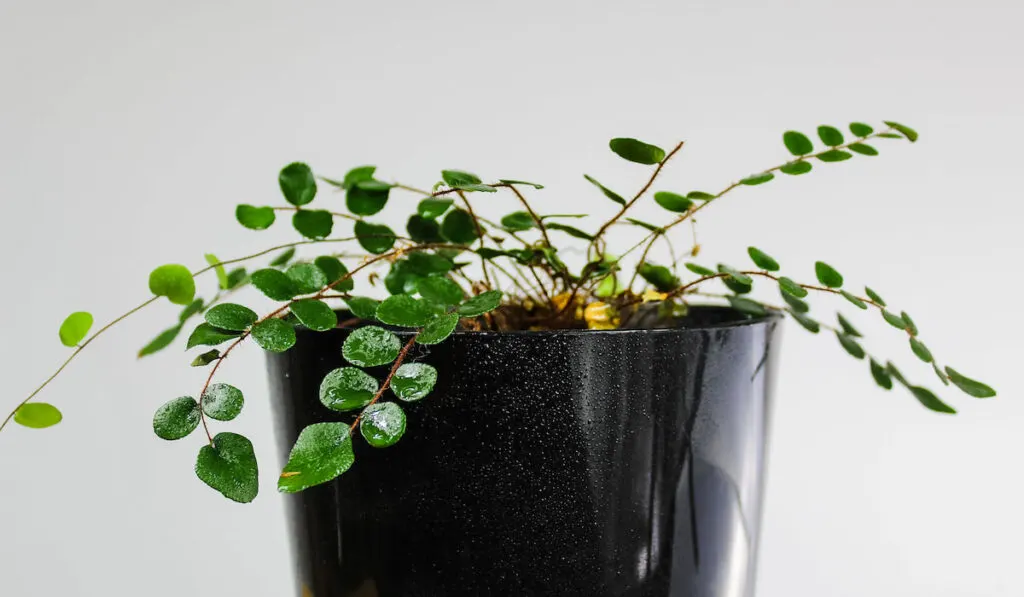
These cute and compact ferns are indigenous to Australia and New Zealand. They are also known as round-leafed ferns.
Button ferns possess deep green, oval-shaped leaves and delicate dark brown stems. As they mature, the color of their foliage and stems will turn darker.
On average, button ferns grow 12 to 18 inches tall. With their small size, you can place them on your work desk, next to your windows, or even in your living room.
However, when growing these ferns indoors, you should always avoid any places with prolonged exposure to direct sunlight.
Frequent watering is highly recommended to keep their soil moist. But be careful not to overwater these plants.
Button ferns thrive in hardiness zones 9 to 11. As long as they receive all necessities and basic living care, these ferns are easy to maintain.
4. Kimberly Queen Fern (Nephrolepis obliterata)
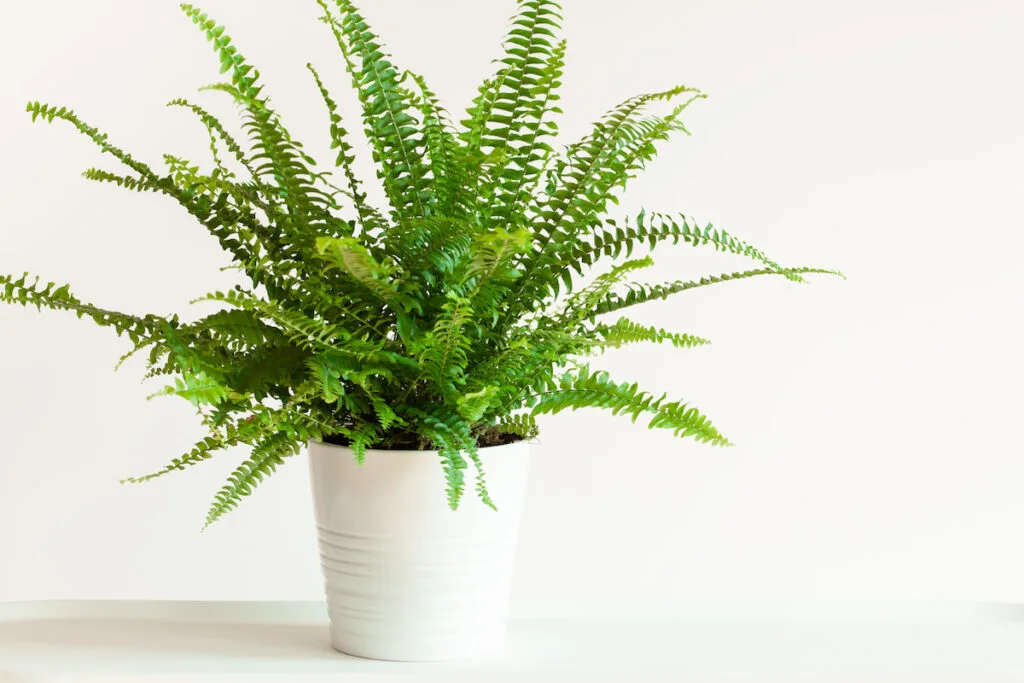
Kimberly Queen ferns can be recognized by their bright green, sword-shaped leaves and thick brown stems. They are also called sword ferns.
These plants are native to Australia and adapt well to warm climates.
Unlike some fern species, Kimberly Queen ferns are considered fast growers. They measure 2 to 3 feet tall and spread 2 to 4 feet wide. These ferns also perform best in hardiness zones 9 to 11.
One of the challenges of growing Kimberly Queen ferns indoors is that this species prefers high humidity and moist environments. Hence, what you can do is place them near sinks, bathrooms, or areas that are close to water sources.
Kimberly Queen ferns grow well in shaded areas with less exposure to direct sunlight. So, avoid growing these plants near unfiltered windows without curtains or blinds. Occasional pruning is also advisable to remove dead leaves while promoting better growth of their fronds.
5. Staghorn Fern (Platycerium spp.)

Staghorn ferns are primarily grown as hanging plants. But you can also cultivate them as potted ferns. These plants are native to Australia, Africa, and Southeast Asia. They are also known as elkhorn ferns.
These tropical-native ferns grow 2 to 3 feet with the same spread. They possess bright green, flat, antler-shaped fronds. These fronds can grow up to 3 feet long.
So, you might need to provide ample space for these ferns when growing them indoors.
Staghorn ferns perform well in hardiness zones 9 to 11. Growing this species is fairly easy. They love warm and humid areas that are partially shaded. Although these ferns can tolerate bright sunlight, prolonged exposure to heat and scorching sun can turn their fronds brown.
Aside from regular watering, you can also add humus or fertilizers to the soil to promote better growth of these ferns.
6. Cretan Brake Fern (Pteris cretica)
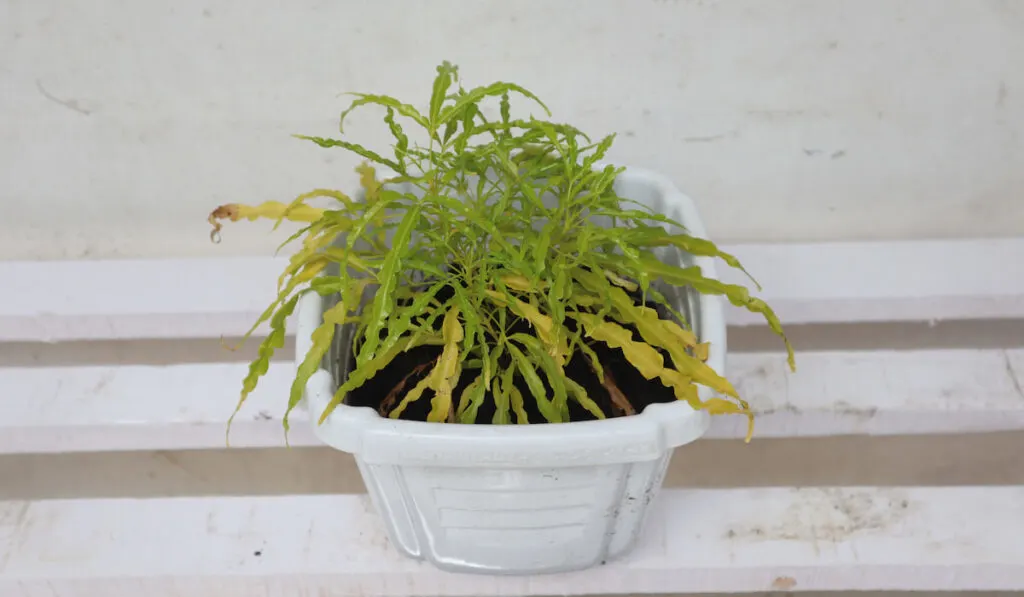
Cretan Brake ferns are indigenous to Asia, Europe, and Africa. They are also called ribbon ferns. In the United States, these ferns grow well in warm and tropical-like regions such as California. Another variety, which is known as variegated brake ferns or Pteris cretica var. albolineata is also popular amongst avid houseplant owners.
Growing 1 to 2 feet tall with the same spread, these ferns possess flat, arched, and two-toned green fronds with jagged edges.
Although these plants can tolerate partial and full sun, they grow best in partially shaded areas or environments with filtered sunlight.
Moisture and humidity also contribute to how well these ferns grow. Simply put, you should never let Cretan Brake ferns live in a dry environment.
7. Japanese Holly Fern (Cyrtomium falcatum)
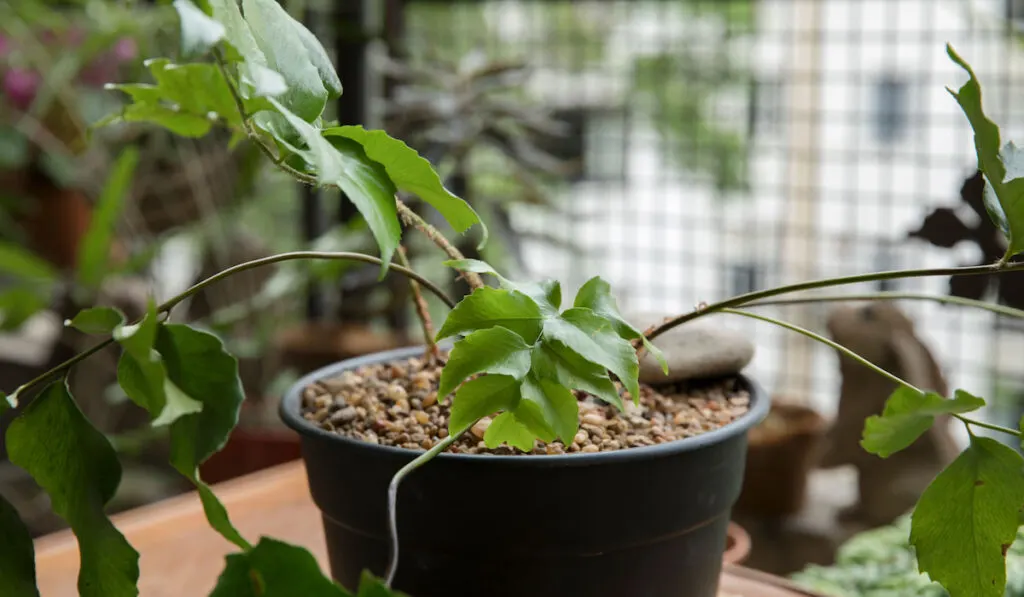
Resembling holly plants, these ferns are native to eastern and southern Asia. They are also known as house holly ferns. These plants thrive in hardiness zones 7 to 10. Like most fern species, Japanese Holly ferns perform well in shaded areas.
You can spot these plants by their sharp, glossy, dark green leaves. Under these leaves, you can find bright green spores that usually turn darker when they mature.
Aside from spores’ germination, new shoots or buds can also grow out of the rhizomes.
Japanese Holly ferns grow 18 to 24 inches tall and spread 24 to 36 inches wide. They can tolerate salty environments and prefer moist, well-drained soil.
8. Golden Serpent Fern (Phlebodium aureum)

Golden serpent ferns hail from the tropical regions of South America. They go by many names such as blue star ferns, hare-foot ferns, cabbage palm ferns, gold-foot ferns, and golden polybody.
These ferns possess multipennate bluish-green fronds with yellowish-golden spores scattered underneath every frond. Other varieties have different frond colors ranging from grayish-green to silvery-green.
On average, golden serpent ferns grow 2 to 4 feet tall and spread 3 to 6 feet wide. These plants thrive in hardiness zones 8 to 13. They also grow well in shaded or partially shaded areas with high humidity.
Aside from occasional watering, you may also want to prune these ferns as soon as you notice their fronds turn yellow or brown. Overall, they are relatively easy to maintain.
9. Hart’s Tongue Fern (Asplenium scolipendrium)

Hart’s Tongue ferns are native to Europe and North America. In the United States, they are widely found in the eastern regions.
You can spot these plants by their large, elongated, glossy, bright green fronds. These fronds usually grow 8 to 16 inches. You may also notice brown, spore-bearing stripes underneath mature fronds.
These ferns measure 12 to 18 inches tall and spread the same. They thrive in hardiness zones 5 to 9 and grow well in partial or fully shaded areas. The best medium to grow Hart’s Tongue ferns is moist and slightly alkaline soil with proper drainage.
You can also grow this species indoors alongside other small companion plants such as mosses, liverworts, hornworts, and other types of ferns.
10. Miniature Tree Fern (Blechnum gibbum)
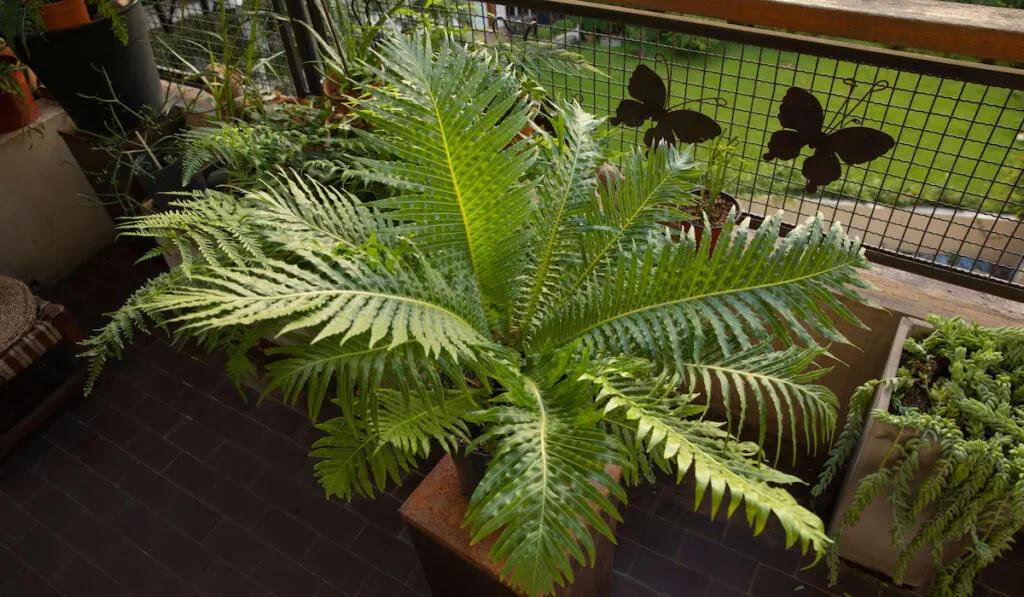
Miniature tree ferns originated from the South Pacific. They also go by their other names such as dwarf tree ferns, silver ferns, and silver lady ferns.
You can recognize these ferns by their small, bright-green fronds that form a shuttlecock-like shape, growing symmetrically from their center base.
At a glance, they might look like a small tree. Miniature tree ferns measure 3 to 4 feet tall and spread the same. Their size alone is enough to show that these plants are perfect for indoor gardening.
Since they are native to tropical and subtropical regions, miniature tree ferns love warm climates and partially shaded areas with bright sunlight. You should also water these ferns regularly to maintain the soil moisture while keeping the humidity around them at an optimum level.
11. Kangaroo Fern (Microsorum diversifolium)
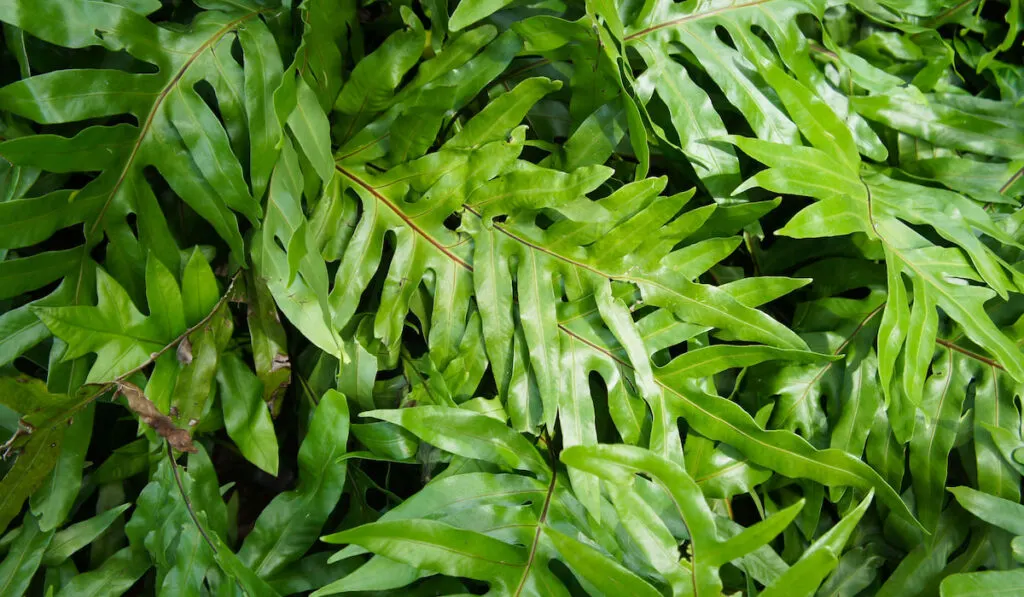
Kangaroo ferns or kangaroo paw ferns are indigenous to Australia and New Zealand.
Their name was derived from the fronds’ shape that resembles a kangaroo’s foot. These fronds come in a glossy, bright green color and measure 6 inches long.
In the wild, they are epiphytic plants that grow above the ground, such as on top of tree branches and dead logs.
These ferns grow up to 12 inches tall and spread up to 4 feet wide. They grow best in hardiness zones 9 to 11, especially in moist, slightly acidic, and well-drained soil. When growing Kangaroo ferns indoors, it is best for you to place them in partially shaded areas that have less exposure to direct sunlight.
With the exception of cold seasons, you should water these ferns regularly to keep them hydrated. Occasional pruning is also great to remove dead leaves while keeping their fronds looking fresh and healthy.
12. Asparagus Fern (Asparagus aethiopicus)

These herbaceous perennials are another great choice for people who are looking for compact, small, and low-maintenance houseplants. Growing 1 to 3 feet tall and a spread which measures 18 to 38 inches, these plants are best grown as potted or hanging plants for house décor or people with small living spaces.
Asparagus ferns are native to South America.
They possess bright green, thick, and feathery foliage that grows outwardly to form a dense and bush-like appearance. Mature plants may also produce indistinct white flowers and berries.
If you have pets or children, it is best to place Asparagus ferns away from them due to the nature of their berries, which can be toxic.
Growing well in hardiness zones 9 to 11, these ferns prefer partial sun or shaded areas with filtered sunlight. They also love moist, slightly acidic, and well-drained soil.
13. Crocodile Fern (Microsorum musifolium)
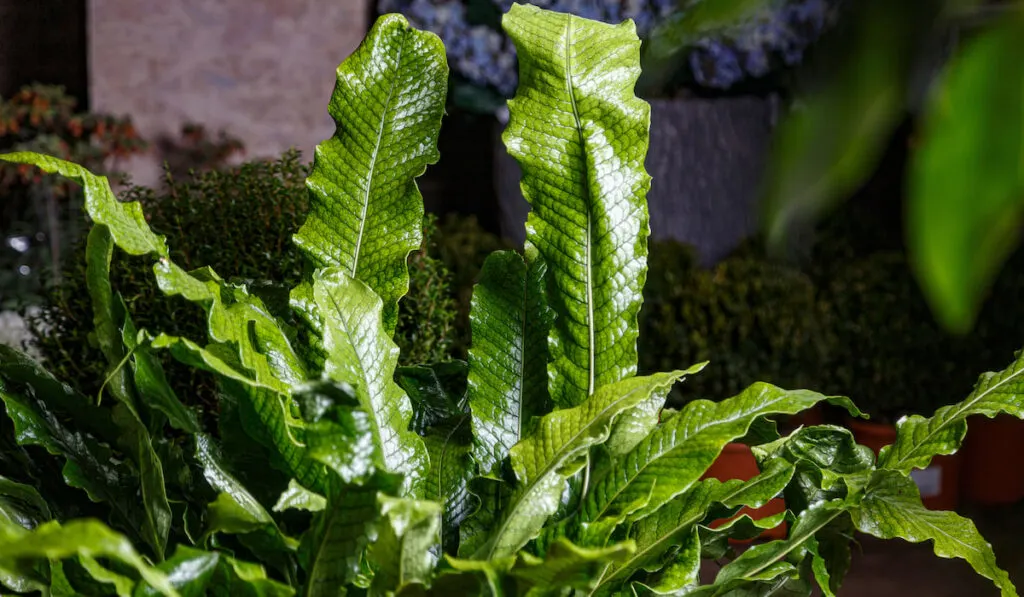
These exotic-looking tropical ferns are native to Australia and Southeast Asia. Their name was derived from the texture and appearance of their fronds, which resemble crocodile skins.
Although they are slow growers, these plants still make one of the great choices for indoor plants.
Crocodile ferns possess variegated and leathery bright green fronds that arch from the central part. They are also called Alligator ferns and Crocodyllus ferns. These ferns grow 2 to 5 feet tall with the same spread. Since they are native to tropical climates, Crocodile ferns perform well in hardiness zones 10 to 11.
To grow this species, you need a humid area with partial shade that doesn’t receive direct sunlight. You will also need to grow these ferns in moist and slightly acidic soil with proper drainage.
Any signs of dried and brown leaves may indicate that these plants are dehydrated or overexposed to sunlight.
14. Eagle Fern (Pteridium aquilinum)

Eagle ferns are widely distributed in many parts of the world such as Europe, North and South America, Asia, Australia, and Africa. They are also known as brake ferns, bracken ferns, and common bracken ferns.
What’s interesting about this species is that the stems from young ferns are consumed as vegetables and side dishes in places like the Asian continent.
However, it is not easy eating them raw. You must soak, boil, and cook the stems thoroughly to remove the carcinogenic compound known as ptaquiloside that exists inside these ferns.
Eagle ferns grow 1 to 3 feet tall and spread 3 to 5 feet wide. You can spot these ferns by their bright green, pinnate leaves that resemble the shape of an eagle’s wings.
They also propagate through underground rhizomes that can grow up to 12 feet deep. The best growing condition for eagle ferns is partially shaded areas and in moist, slightly acidic, and well-drained soil.
15. Long Strap Fern (Campyloneurum phyllitidis)
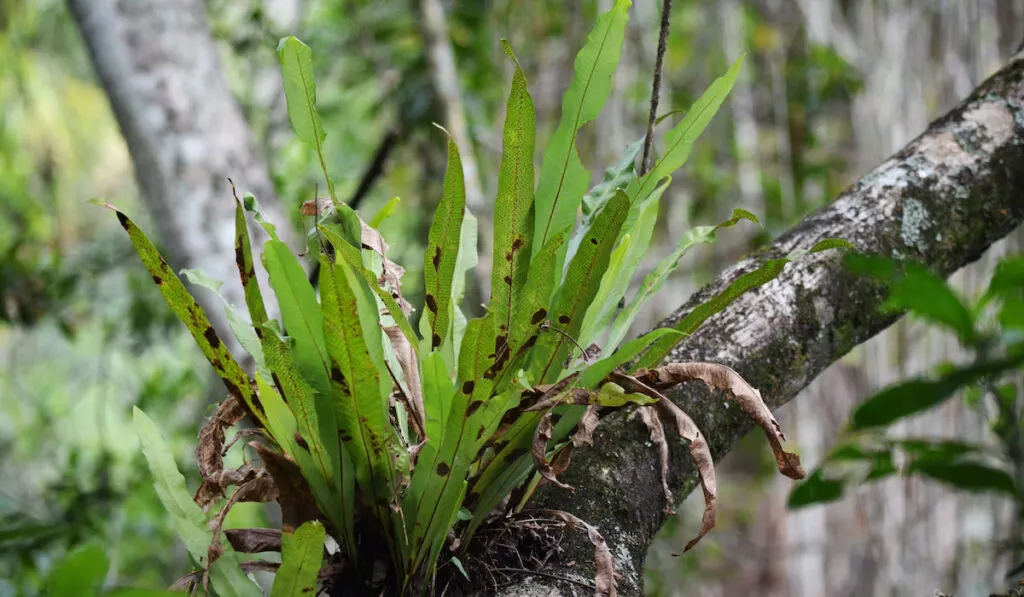
Long strap ferns are native to Central, North, and South America, particularly in Venezuela, Peru, Brazil, Paraguay, Costa Rica, Cuba, the Caribbean, and the United States.
They are epiphytes that grow on other surfaces such as tree trunks and branches, dried logs, and even rocks. These perennials are also called cow tongue ferns.
On average, long strap ferns grow 2 feet tall and spread the same.
They have long and leathery yellowish-green fronds with wavy edges that measure up to 39 inches long and 5 inches wide. You can also notice clusters of spores underneath their fronds.
Long strap ferns perform best in hardiness zones 9 to 10. They prefer partially shaded areas without direct exposure to bright sunlight. These plants grow well in moist and well-drained soil. They also propagate through rhizome division.
16. Lacy Tree Fern (Cyathaea cooperi)
Lacy tree ferns are widely distributed in the eastern regions of Australia. These tropical plants are also known as Australian tree ferns, scaly tree ferns, and Cooper’s tree ferns.
When they’re cultivated as houseplants, these ferns grow 15 to 25 feet tall and spread 10 to 12 feet. But in the wild, they can reach up to 50 feet tall. So, make sure to place these plants in rooms or spaces with soaring ceilings.
You can recognize lacy tree ferns by their lacy, pale-green, feather-like fronds and thick scaly brown stems. Both their fronds and stems are also covered with delicate hairs.
These plants thrive in hardiness zones 9 to 11. They prefer partially shaded areas and moist, slightly acidic, and well-drained soil.
Being one of the fastest-growing ferns, lacy tree ferns propagate through spores. They also don’t encounter many plant diseases, except for the occasional mealybugs and mite attacks.
17. Squirrel’s Foot Fern (Davallia bullata)
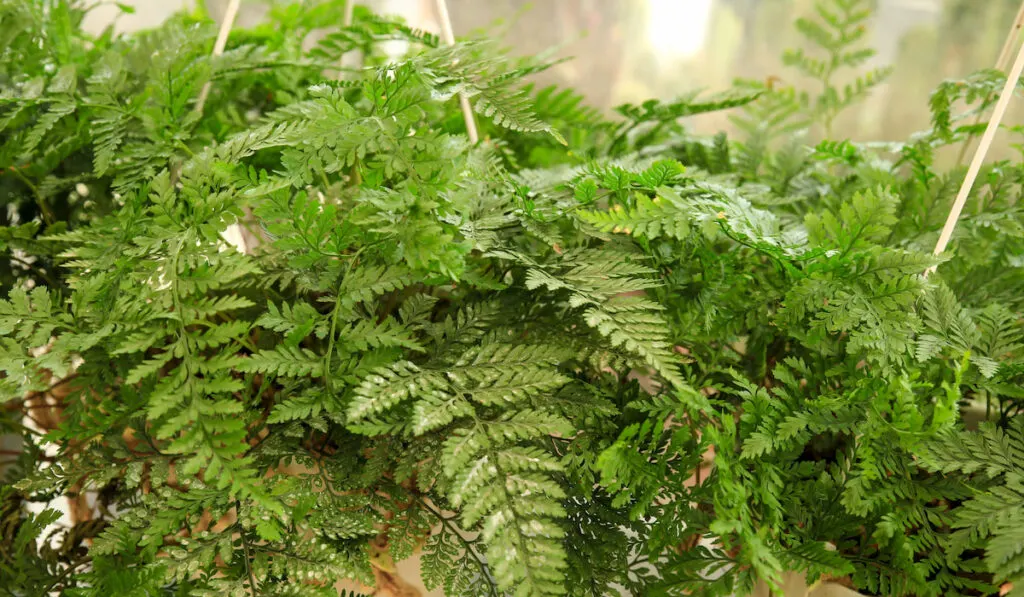
Squirrel’s foot ferns are native to Asia, specifically Japan and China. They belong to the family Davalliaceae and are closely related to Rabbit’s foot ferns.
Squirrel Foot fern plants possess pale green, linear-shaped fronds, and slender brown stems.
These ferns were named after their rhizomes’ shape which resembles a squirrel’s foot. On average, squirrel’s foot ferns grow 8 to 14 inches tall. They perform best in hardiness zones 10 and 11. Although these ferns can tolerate full sun, they prefer shady areas with filtered bright light.
Squirrel’s foot ferns are sensitive to dry environments. Hence, you should water these plants frequently to retain the soil moisture, but not to the point of overwatering them. You can also use planter mist to keep their fronds fresh and wet.
Final Thoughts
No matter which type of fern you choose, ferns are generally easy to maintain. Some of these plants are also much smaller than your average potted houseplants.
Hence, if extra space is your main concern, having ferns as indoor plants would certainly solve that problem. Plus, you don’t have to overspend on buying lush and heavy-blooming flowers just to make a statement. Indoor ferns are exotic enough to bring out the uniqueness of your living space.
Resources
- https://www.thespruce.com/grow-adiantum-ferns-1902722
- https://www.gardeningknowhow.com/houseplants/ferns-houseplants/indoor-maidenhair-fern.htm
- https://www.thespruce.com/grow-asplenium-nidus-ferns-1902716
- https://www.gardenia.net/plant/asplenium-nidus
- https://plantify.co.za/pages/button-fern-care-instructions
- https://www.gardenista.com/posts/gardening-101-button-fern/
- https://www.diys.com/growing-kimberley-queen-ferns/
- https://www.thespruce.com/growing-kimberly-queen-ferns-5101495
- https://www.thespruce.com/grow-platycerium-species-1902725
- https://www.gardeningknowhow.com/ornamental/foliage/staghorn-fern/staghorn-fern-information.htm
- https://en.wikipedia.org/wiki/Pteris_cretica
- https://www.thespruce.com/grow-pteris-indoors-1902724
- https://www.mydomaine.com/kangaroo-paw-5113933
- https://www.gardeningknowhow.com/houseplants/kangaroo-paw-fern/growing-kangaroo-foot-ferns.htm
- https://en.wikipedia.org/wiki/Cyrtomium_falcatum
- https://plants.ces.ncsu.edu/plants/cyrtomium-falcatum/
- https://www.monrovia.com/japanese-holly-fern.html
- https://plants.ces.ncsu.edu/plants/phlebodium-aureum/
- https://plantura.garden/uk/houseplants/blue-star-fern/blue-star-fern-overview
- https://www.gardenia.net/plant/asplenium-scolopendrium-harts-tongue-fern
- https://www.gardeningknowhow.com/ornamental/foliage/harts-tongue-ferns/harts-tongue-fern-care.htm
- https://www.gardenersworld.com/plants/blechnum-gibbum/
- https://plantcaretoday.com/blechnum-gibbum.html
- https://www.thespruce.com/grow-asparagus-ferns-1902714
- https://www.gardeningknowhow.com/ornamental/foliage/asparagus-fern/asparagus-fern-care.htm
- https://www.thespruce.com/caring-for-crocodile-ferns-5076287
- https://plantlegend.com/blogs/info/how-to-take-care-of-a-crocodile-fern/
- https://arboretum.ucf.edu/virtual/bracken-fern/
- https://en.wikipedia.org/wiki/Pteridium_aquilinum
- https://www.lotuswei.com/blogs/blog/flowers-eagle-fern-flower-essence
- https://garden.org/plants/view/142873/Long-Strap-Fern-Campyloneurum-phyllitidis/
- https://en.wikipedia.org/wiki/Campyloneurum_phyllitidis
- http://www.wildsouthflorida.com/long.strap.fern.html
- https://www.thespruce.com/australian-tree-fern-overview-1902715
- https://www.gardenia.net/plant/cyathea-cooperi
- https://www.picturethisai.com/wiki/Davallia_bullata.html
- https://greencloudsolutions.co.za/shop/trees/ornamental/squirrels-foot-fern-davallia-bullata/
- https://en.wikipedia.org/wiki/Davallia_bullata
